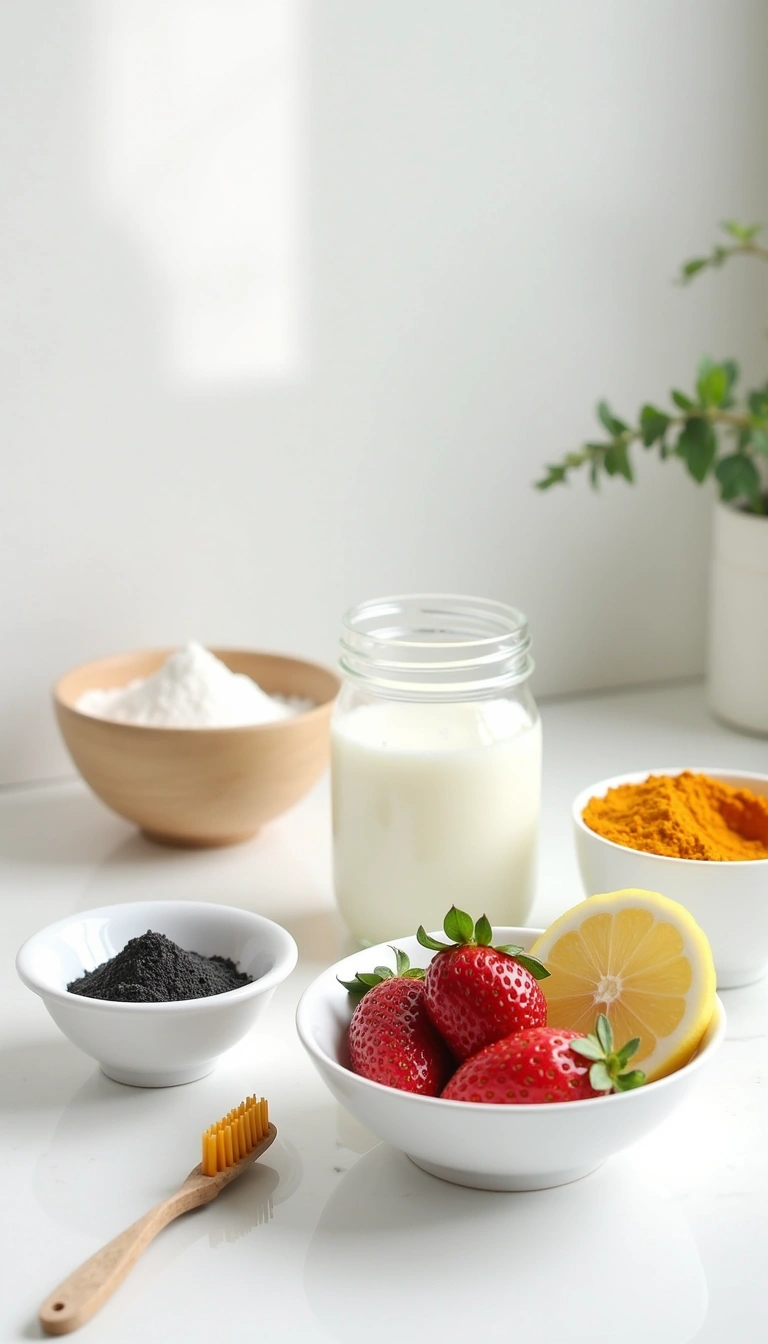People try countless natural teeth whitening methods to brighten their smiles without expensive dental treatments. Your kitchen likely holds several ingredients that promise whiter teeth. Many folks swear by these home remedies passed down through generations. Let’s explore what actually works and what might waste your time.
1. Brush With Baking Soda

Baking soda acts as a mild abrasive that scrubs away surface stains on your teeth. It also creates an alkaline environment in your mouth that prevents bacteria from growing.
Mix one teaspoon of baking soda with two teaspoons of water to form a paste. Brush gently for two minutes, then rinse thoroughly. Studies show baking soda toothpaste removes plaque more effectively than regular toothpaste.
Take Charge of Your Health with The Home Doctor
Discover real-world remedies and first-aid solutions you can use when help isn’t around.
👉 Claim Your Home Doctor GuideTip: Use this method only 2-3 times per week to avoid damaging your tooth enamel.
2. Oil Pulling With Coconut Oil
Oil pulling involves swishing oil in your mouth to remove bacteria and toxins that cause yellowing. Coconut oil contains lauric acid, which kills harmful bacteria and reduces inflammation in your gums.
Take one tablespoon of coconut oil and swish it around your mouth for 10-15 minutes each morning. Spit it out in the trash (not the sink) and brush your teeth normally. Ancient Ayurvedic practitioners used this technique thousands of years ago.
Takeaway: Start with 5 minutes if 15 feels too long, then gradually increase the time.
3. Create a Hydrogen Peroxide Rinse
Hydrogen peroxide is a natural bleaching agent that kills bacteria in your mouth. Many commercial whitening products contain this ingredient, though in higher concentrations.
Mix equal parts 3% hydrogen peroxide and water to create a safe mouth rinse. Swish for 30 seconds before brushing your teeth. The American Dental Association recognizes hydrogen peroxide as safe for oral use when diluted properly.
Tip: Never swallow hydrogen peroxide, and don’t use concentrations higher than 3%.
4. Rub Your Teeth With Lemon Peels
Lemon peels contain d-limonene, a compound that may help break down stains on tooth surfaces. The oils in citrus peels have natural whitening properties that some people find effective.
Gently rub the white part of a fresh lemon peel on your teeth for 2 minutes. Rinse your mouth with water immediately afterward. However, the citric acid in lemons can erode enamel over time.
Takeaway: Wait at least 60 minutes after using lemon peels before brushing to protect softened enamel.
5. Make a Strawberry and Baking Soda Paste
Strawberries contain malic acid, which may help remove surface stains from teeth. When combined with baking soda’s abrasive properties, this mixture creates a natural whitening treatment.
Mash one ripe strawberry and mix it with half a teaspoon of baking soda. Apply the paste to your teeth with a toothbrush and leave for 5 minutes. A study found this combination slightly improved tooth color, though results were minimal.
Tip: Brush with regular toothpaste afterward to remove any strawberry residue and natural sugars.
6. Eat Pineapple for Natural Enzymes
Pineapple contains bromelain, an enzyme that may help break down stains and remove plaque buildup. This natural enzyme also has anti-inflammatory properties that benefit your gums.
Eat fresh pineapple regularly or rub a piece directly on your teeth for 2 minutes. Research shows that toothpaste containing bromelain removes stains more effectively than standard toothpaste. Canned pineapple won’t work as well since processing reduces enzyme activity.
Takeaway: Choose fresh, ripe pineapple for maximum bromelain content and whitening benefits.
7. Use Apple Cider Vinegar as a Mouth Rinse
Apple cider vinegar has antibacterial properties that can kill harmful bacteria and remove stains. It’s been used as a natural cleaning and disinfecting agent for centuries.
Dilute apple cider vinegar with water in a 1:2 ratio and swish for 30 seconds. Rinse with plain water immediately after. The acetic acid in vinegar can erode tooth enamel, so limit use to once or twice weekly.
Tip: Always dilute apple cider vinegar and never use it undiluted on your teeth.
8. Brush With Activated Charcoal
Activated charcoal is highly absorbent and may bind to stains and bacteria in your mouth. This black powder has become popular in natural health circles for detoxification purposes.
Wet your toothbrush and dip it in activated charcoal powder. Brush gently for 2 minutes, then rinse thoroughly until water runs clear. Some people report whiter teeth after several uses, though scientific evidence remains limited.
Takeaway: Choose food-grade activated charcoal and brush very gently to avoid scratching enamel.
9. Try Turmeric Paste
Turmeric contains curcumin, which has anti-inflammatory and antimicrobial properties. Despite its yellow color, some people claim turmeric helps whiten teeth over time.
Mix turmeric powder with water or coconut oil to form a paste. Brush with this mixture for 2 minutes, then rinse well. Ancient Indian medicine has used turmeric for oral health for thousands of years.
Tip: Use an old toothbrush since turmeric will stain it permanently yellow.
10. Scrub Gently With Sea Salt
Sea salt acts as a natural abrasive that can scrub away surface stains and bacteria. It also contains minerals that may benefit your oral health and gum tissue.
Mix a pinch of fine sea salt with your regular toothpaste or water. Brush gently for 1-2 minutes to avoid damaging enamel. Coarse salt can scratch your teeth, so choose finely ground varieties.
Takeaway: Use this method sparingly – once weekly at most – to prevent enamel erosion.
11. Eat Whitening Foods Regularly
Certain foods naturally clean your teeth while you chew and provide nutrients that support oral health. Crunchy fruits and vegetables act like natural toothbrushes.
Include apples, celery, carrots, and leafy greens in your daily diet. These foods increase saliva production, which helps wash away stains and bacteria. Dairy products like cheese and yogurt provide calcium that strengthens tooth enamel.
Tip: End meals with whitening foods to help clean your teeth naturally throughout the day.
12. Make a Banana Peel Rub
Banana peels contain potassium, magnesium, and other minerals that may help remove stains from tooth surfaces. This method is gentle and won’t damage your enamel like acidic treatments.
Rub the inside of a ripe banana peel on your teeth for 2-3 minutes. Let the minerals sit for 10 minutes before brushing normally. While scientific evidence is lacking, many people report positive results from this gentle approach.
Takeaway: Choose ripe bananas with plenty of white residue inside the peel for best results.
13. Rinse With Green Tea
Green tea contains catechins, which are antioxidants that fight bacteria and reduce inflammation in your mouth. These compounds may also help prevent new stains from forming on your teeth.
Brew green tea and let it cool completely before using as a mouth rinse. Swish for 30-60 seconds twice daily. Studies show that green tea can reduce harmful bacteria in the mouth and improve overall oral health.
Tip: Don’t add sugar or honey to your green tea rinse, as these can feed harmful bacteria.
14. Create an Orange Peel Scrub
Orange peels contain d-limonene and vitamin C, which may help break down stains and kill bacteria. The texture also provides gentle abrasive action to remove surface buildup.
Rub fresh orange peel directly on your teeth for 2 minutes, focusing on stained areas. Rinse thoroughly with water afterward. Like other citrus peels, orange peels can soften enamel temporarily due to their acid content.
Takeaway: Wait at least one hour after using orange peels before brushing your teeth with toothpaste.
15. Try Whitening With Papaya
Papaya contains papain, an enzyme that may help break down protein-based stains on your teeth. This tropical fruit also provides vitamin C and other nutrients that support gum health.
Mash ripe papaya into a paste and apply it to your teeth for 5 minutes. You can also rub papaya pieces directly on stained areas. Some whitening toothpastes include papain as an active ingredient.
Tip: Choose very ripe papaya for maximum enzyme content and natural sweetness.
16. Use Milk and Dairy Products
Dairy products contain lactic acid, calcium, and phosphorus that strengthen tooth enamel and may help remove stains. The proteins in milk can also bind to harmful bacteria in your mouth.
Drink milk regularly or swish it around your mouth before swallowing. Plain yogurt and cheese provide similar benefits. Research shows that people who consume more dairy tend to have stronger, whiter teeth.
Takeaway: Choose unsweetened dairy products to avoid feeding cavity-causing bacteria with added sugars.
17. Practice Good Oral Hygiene
The most effective natural whitening method is preventing stains before they form. Consistent brushing, flossing, and rinsing remove plaque and bacteria that cause yellowing over time.
Brush twice daily with fluoride toothpaste and floss at least once per day. Rinse with water after consuming staining foods or drinks like coffee, tea, and red wine. Regular dental cleanings every six months also help maintain your natural tooth color.
Tip: Use a straw when drinking dark liquids to minimize contact with your teeth.

Lifebing is driven by an unrelenting passion for promoting health and well-being, our team is wholly committed to curating exceptional content and immersive experiences.
